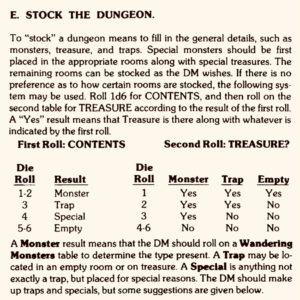There are many broad functions that rules can have. Here is one: representing the details of a broader fictional world. The fictional world might not work exactly like the world of day to day phenomenological experience that we inhabit and experience as the real world, but it nonetheless makes sense, loosely speaking. Sure, monsters might exist that we have never encountered and sorcerers might be able to, with long study, cast spells to open portals. But there remains the basic assumption that behind the scenes there is a living, breathing world that both shapes and constrains the shared imagination of play.
Call these reflective rules. Rules as the physics of the imagined world. That is, the rules reflect the imagined campaign. In reflective rules, the cause is (conceptually) outside the formal game elements. A rule is a good rule if it produces logical and realistic outcomes, relative to the shared understanding of the campaign setting. This is a common-sense vernacular approach, and it has had a wide currency, arguably undergirding most mainstream tabletop roleplaying games from varieties of TSR D&D to Rolemaster to D&D 5E. The assumption that rules should reflect the campaign world is something like the equivalent of Literary Realism for tabletop roleplaying games. It is the equivalent of what you get most of the time if you watch a serial drama on Neflix or pick up an airport novel.
Here is another function rules can have: determining the situations and details of play. Call these formative rules. The results may or may not make sense fictionally, but they are the rules, so you execute them and then interpret the outcomes as best you can. The fireball might detonate in a square. The random encounter generates a dragon one hex outside of town, three times in a row. The rules form the situation of play. In formative rules, the cause is (conceptually) the rules themselves and interpretation happens (if at all) subsequently. When one stocks a dungeon using the B/X procedures presented on page B52, the outcome is not really intended to model any kind of naturalistic situation. It might, but the goal is not logic or naturalism. You need monsters and treasures and traps in some rough distribution for the game to work, so the rule does that. Consider traditional spell slots. Sure, there is some very loose Vancian inspiration, but really original style D&D spells need limits of some sort to support challenges. Fire and forget is a way to do that. If one adopts the approach of assuming D&D is always right, that is in the mode of formative rules.
The most effective formative rules are designed to generate the dynamics and situations necessary to a particular game. They create satisfying tension and result in outcomes where player decisions matter. They can provide oracles into the imagined world. They might facilitate complex tactical contests or generate genre-appropriate thematic outcomes. Formative rules can also provide practical support for simplifying or abstracting elements of an imagined world which might be impractical to model explicitly. Additionally, the interpretation and reconciliation required by occasionally illogical results can serve as an engine of creativity. What might explain three dragon encounters in a row, so near to civilization? However, thoughtlessly designed or applied formative rules can be a straitjacket or procrustean bed, trapping players in abstract or solipsistic formalism, rewarding optimization and homework.
Does this matter, or is it just semantics, another arbitrary taxonomy to create more specialist language? It seems to me that the potential of the form, what tabletop roleplaying can uniquely provide compared to other forms of entertainment, media, and art, involves a fusion of these two modes.
If one leans too heavily on formative rules, where players weave results into some shared narrative fabric unrelated to any ideal of living breathing world, one risks losing the richness of possibility inherent in the idea of a campaign with integrity. Pathologies of formative rules include repetitive outcomes and the peasant railgun. That idea of the campaign world as external, causal source, along with some degree of shared commonsense understanding of how things work, is what enables principled and flexible rulings at the table.
If one leans too heavily on reflective rules, where logic and verisimilitude dominate, one gets lost in minutiae unconnected to the experience of play. Pathologies of reflective rules include, in the D&D context, Shopkeepers & Spreadsheets and fixation on realistic fictional economies at a level of detail far exceeding relevance to play. The OSR etc aversion to extensive fictional histories and backstories is not just a practical norm, nor is it just a rejection of tabletop roleplaying as a thespian concern; this aversion is also a recognition that the most useful elements of setting are those that provide contact surfaces for play at the table.
Ideally, a campaign is both internally consistent and makes sense on its own terms, broadly speaking, but simultaneously provides a stage for play with all of the concerns that entails. The reflective and formative components can feed back into each other, providing mutual enrichment. Some idiosyncratic element of a campaign setting might emerge from a seemingly illogical random stocking result (formative) later interpreted and explained in the logic of the setting, informing later concrete details and rulings experienced by players in play (reflective).
I tried real hard to avoid bogging this post down with technical jargon. However, to give credit where credit is due I will note that these ideas are related to formative and reflective constructs in the philosophy of science. This article is a good on ramp:
Edwards, J. R., & Bagozzi, R. P. (2000). On the nature and direction of relationships between constructs and measures. Psychological Methods, 5(2), 155–174.


